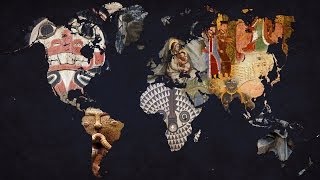(单词翻译:单击)
It's only been the last few hundreds years or so that Western civilization has been putting art in museums,
西方文明在博物馆展现艺术品是近几百年才有的,
at least museums resembling the public institutions we know today.
起码是在类似如今所熟悉的博物馆中。
Before this, for most, art served other purposes.
在这之前,大致上,艺术有其他用途。
What we call fine art today was, in fact, primarily how people experienced an aesthetic dimension of religion.
如今所谓的艺术其实主要来自人们对宗教审美的体验。
Paintings, sculpture, textiles and illuminations were the media of their time, supplying vivid imagery to accompany the stories of the day.
绘画、雕塑、纺织品、彩饰,是当时的媒体以生动的图像搭配当时的故事。
In this sense, Western art shared a utilitarian purpose with other cultures around the world,
从某种意义上讲,西方艺术和其他世界文化有共同的功利宗旨,
some of whose languages incidentally have no word for art.
还有,某些语言并没有表达“艺术”的词汇。
So how do we define what we call art?
那么所谓的艺术要如何定义?
Generally speaking, what we're talking about here is work that visually communicates meaning beyond language,
一般来说,我们在此讨论的是以视觉作品传达超语言的意义、
either through representation or the arrangement of visual elements in space.
通过画像或视觉元素的空间排列。
Evidence of this power of iconography, or ability of images to convey meaning,
意象力量的证据或图像传达意思的能力,
can be found in abundance if we look at art from the histories of our major world religions.
可在世界主要宗教的历史中找寻到很多。
Almost all have, at one time or another in their history, gone through some sort of aniconic phase.
几乎所有宗教的历史中都曾经过某种反圣像的阶段。
Aniconism prohibits any visual depiction of the divine.
反圣像论禁止任何神圣的视觉描绘。
This is done in order to avoid idolatry, or confusion between the representation of divinity and divinity itself.
这是为了避免偶像崇拜,或避免神和其画像之间的混淆。
Keeping it real, so to speak, in the relationship between the individual and the divine.
可以说,是为了在个人和神的关系上保持真实。
However, this can be a challenge to maintain,
但保持这种状态会是一项挑战,
given that the urge to visually represent and interpret the world around us is a compulsion difficult to suppress.
特别是要以视觉显示和解释周遭世界,是一个很难抑制的冲动。
For example, even today, where the depiction of Allah or the Prophet Muhammad is prohibited,
例如,即使在今天对真主或先知穆罕穆德的描述是禁止的,
an abstract celebration of the divine can still be found in arabesque patterns of Islamic textile design,
但一个抽象庆祝的神可以在阿拉伯样式或伊斯兰图案中发现,
with masterful flourishes of brushwork and Arabic calligraphy,
有着娴熟的画工与阿拉伯书法,
where the words of the prophet assume a dual role as both literature and visual art.
先知的话是文学和视觉的双重艺术。

Likewise, in art from the early periods of Christianity and Buddhism,
同样,在基督教和佛教的早期艺术当中,
the divine presence of the Christ and the Buddha do not appear in human form but are represented by symbols.
基督和佛陀的神圣的存在,不是以人体呈现,而是以符号代表。
In each case, iconographic reference is employed as a form of reverence.
在这些情况下,图像的引用是一种崇敬。
Anthropomorphic representation, or depiction in human form,
拟人化的表现,或人形描绘,
eventually became widespread in these religions only centuries later, under the influence of the cultural traditions surrounding them.
要在几世纪后受到周遭文化传统的影响,才在宗教中变得普遍。
Historically speaking, the public appreciation of visual art
从历史上看,大众的视觉艺术欣赏
in terms other than traditional, religious or social function is a relatively new concept.
相对其他传统、宗教或社交活动,是一种较新的概念。
Today, we fetishize the fetish, so to speak.
今天,我们越来越盲目迷恋。
We go to museums to see art from the ages,
我们会去博物馆看历代艺术,
but our experience of it there is drastically removed from the context in which it was originally intended to be seen.
但我们所体验的,却和艺术作品本身想要被人所看到的环境彻底脱离。
It might be said that the modern viewer lacks the richness of engagement that she has with contemporary art,
可以说,如今的艺术欣赏者缺少与当代艺术品的完美融合,
which has been created relevant to her time and speaks her cultural language.
艺术的创造和观众所处的历史阶段有关联,艺术还会讲述与观众相关的文化语言。
It might also be said that the history of what we call art is a conversation that continues on,
也可以说,我们所谓的艺术的历史,就是一次仍在继续的谈话,
as our contemporary present passes into what will be some future generation's classical past.
我们现当代的艺术将会成为未来一代经典的过去。
It's a conversation that reflects the ideologies, mythologies,
这是一次反映了意识形态、神话、
belief systems and taboos and so much more of the world in which it was made.
信仰、禁忌及更多其他构成这世界的元素的谈话。
But this is not to say that work from another age
但这不表示,另一时代的作品,
made to serve a particular function in that time is dead or has nothing to offer the modern viewer.
其当时的特定功能对于现代观众毫无意义。
Even though in a museum setting works of art from different places and times are presented alongside each other,
虽然在博物馆中,不同地点及时代的艺术作品会毗邻展示,
isolated from their original settings, their juxtaposition has benefits.
脱离最初的设置,但它们的这种并列是有益处的。
Exhibits are organized by curators,
展品是由策展人安排,
or people who've made a career out of their ability to recontextualize or remix cultural artifacts in a collective presentation.
或是一些可以赋予艺术品新背景或新组合的人,再通过集体方式呈现出来。
As viewers, we're then able to consider the art in terms of a common theme that might not be apparent in a particular work until you see it alongside another,
作为观众,我们将能看到在单一艺术作品中不易发现、但因并列展示而显出的共同主题,
and new meanings can be derived and reflected upon.
由此悟出新意义及感想。
If we're so inclined, we might even start to see every work of art
如果有心,我们还可开始将每件艺术作品,
as a complementary part of some undefined, unified whole of past human experience,
视为对过去人类经验中无定义、统一总体的部分补充,
a trail that leads right to our doorstep and continues on with us, open to anyone who wants to explore it.
一个延向我们的线索,再由我们延续,向所有想探索它的人敞开。


